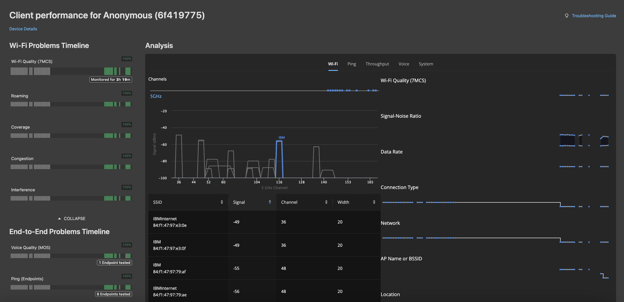Blog
7SIGNAL supports 6GHz monitoring unlike any other solution on the market! In this brief article, we’ll walk you through the 6GHz spectrum monitoring use case, which was designed to help organizations that rely on high-quality Wi-Fi experiences for their end users.
In our last blog post we noted that Wi-Fi 6 and Wi-Fi 6E deliver a ton of value to enterprises. Their speed and capacity improvements enable organizations to build more efficient Wi-Fi environments that provide end users with better all around connectivity experiences. This manifests in more reliable video conferencing capabilities, expanded IoT and M2M use cases, and the ability to support more users on more devices doing more things.
Nevertheless, just because you’ve upgraded your organization's networks and devices to support Wi-Fi 6 it doesn’t mean your employees will automatically reap of the rewards.
This is where 7SIGNAL comes into the picture! While 7SIGNAL has long enabled organizations to monitor wireless user experiences, it now supports the 6GHz band. As such, you can use it to measure Wi-Fi 6 usage and make sure your end users are making the most of it.
Here’s what we cover in this article:
Want to learn more about the 7SIGNAL platform? Chat with our sales team!
Using 7SIGNAL Endpoint agents to Monitor 6GHz Connections
Upgrading your enterprise Wi-Fi environment to 6GHZ isn’t cheap. Especially when it entails acquiring the latest and greatest access points, switches, etc. So, if you make the leap and invest in network elements that support Wi-Fi 6 and Wi-Fi 6E, you should make sure you’re getting the most out of your dollar.
With 7SIGNAL’s Wi-Fi optimization platform, you can assess Wi-Fi channel usage from the perspective of user devices. Here’s how:

7SIGNAL aggregates up to 90 days’ worth of data collected from devices operating in your network. And, with our latest release, you can use it to monitor how much device traffic flows via the 6GHz spectrum.
Here, you can see insights for one particular device:
As you can see, you can track devices as they move from one band of spectrum to the next:

In other words, you’ll be able to determine whether or not your users are actually taking advantage of the 6GHz access points operating in your network.
For example, here are all 6GHz APs currently operating in our lab:
You can see the 6GHz spectrum, from channel 1 through channel 233. In the example above, you can even see that we're testing a variety of 160MHz-wide channels.
But what's really cool is that you can also see which channel a device is currently on — that is, its primary channel. The reason this is handy is because your primary channel is where all of your management traffic is flowing. So, with the latest 7SIGNAL release, you can identify this channel quickly and easily.
And there you have it! If you’d like to learn more about these new release, set up a meeting with our team!
see it in action: 7 Minutes with 7SIGNAL
Eric Camulli, VP and Customer Success Officer at 7SIGNAL, covered the subject above in a recent segment on our weekly webinar. You can watch the full recording here:
Learn More From the 7SIGNAL Experts
We’re always here to answer your Wi-Fi questions at 7SIGNAL. Our enterprise Wi-Fi optimization platform helps you plan and execute a healthier network. Contact us to learn more.
7SIGNAL® is the leader in enterprise Wi-Fi optimization, providing insight into wireless networks and control over Wi-Fi performance so businesses and organizations can thrive. Our cloud-based platform continually tests and measures Wi-Fi performance at the edges of the network, enabling fast solutions to digital experience issues and stronger connections for mission-critical users, devices, and applications. Learn more at www.7signal.com.